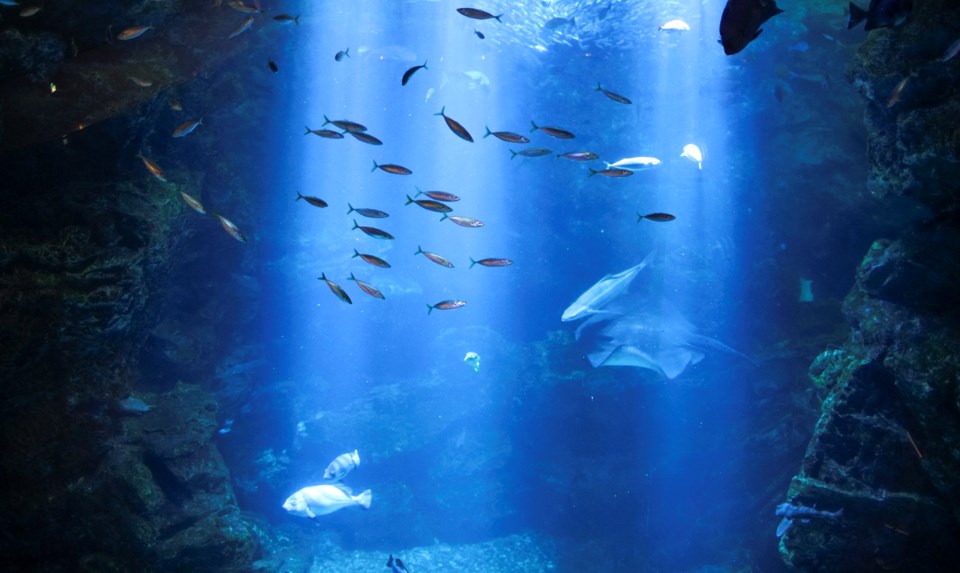For a long time, the great ocean explorers used sight to reveal the secrets of the marine environment, downplaying its acoustic aspects. Indeed, the ocean has long been considered a place devoid of any sound.
This belief originated when Jacques-Yves Cousteau and his companions produced a remarkable feature film about the marine environment, The Silent World. Scuba divers often appear to be swimming through a calm and muffled universe, where communication between animals is done through through visual displays and chemistry.
Today, however, numerous studies underline the importance of sound for a multitude of marine species. Cetaceans — whales, dolphins and porpoises — are excellent ocean orators, capable of communicating at distances greater than 2,000 kilometres.
Even the smallest animals living at the bottom of the sea, which play a fundamental role in maintaining the balance of ecosystems, may communicate with each other through sound. I’m trying to answer this question as part of my doctoral studies at UQAR. Ultimately, we want to know if noise pollution has significant effects on the behaviour and communication of marine animals.
Sound is essential to the life of marine animals
Recent studies demonstrate that the natural soundscape and the sounds emitted by the animals themselves play an important role in regulating different aspects of the life of marine invertebrates (animals without an internal skeleton). From an early age, the tiny floating larvae of mussels, scallops and oysters seem to be influenced by the noise present in the environment around them.
Surprisingly, these larvae seem to be attracted to noises. For example, oyster larvae are more likely to settle in an environment exposed to sounds produced by their fellow creatures, as the sounds are an excellent index of places conducive to life.
Sound also remains a fundamental aspect for the survival of animals in adulthood — and for their reproduction. Some species of molluscs can perceive their acoustic landscape to synchronize their seasonal spawning, and increase the chances of fertilization.
For crustaceans, studies suggest that male European lobsters produce buzzing sounds during competitive encounters through low-frequency vibrations of the carapace to repel competitors. This communication strategy, adopted by different marine and terrestrial species to announce their presence to their adversaries, helps them avoid potentially costly and damaging physical confrontations.
Sounds can also be used by marine invertebrates warn each other of danger, such as a predator. The flapping of the valves of a fleeing scallop and the rhythmic beating of a sea slug against the shell bottom may be warning signals. When an octopus attacks a lobster, it tries to discourage the attacker by making intimidating noises.
Ocean noise pollution: A major challenge
Water is an excellent medium for sound propagation, much better than air, so it is realistic to think that a large majority of marine animals obey sound signals. Until now, this phenomenon has been largely overlooked, largely because many ocean sounds remain inaudible to our ears. The crab, however, may perceive the seabed as a long succession of different noises.
Many questions still remain unanswered for the moment, but technological progress will help scientists discover other wonders that the ocean still kept secret.
One thing remains certain: Human activities have introduced noise pollution into the marine environment, and organisms must find ways to adapt to this change. The construction of new infrastructure and the transport of goods are increasingly sources of noise pollution in our seas.
In the Far North, as the sea ice melts and new trade routes open up, new acoustic landscapes will be created. Their effects on local fauna will need to be evaluated.
Scientists have already shown that animal physiology and behaviour are affected by degrading its natural soundscape. Many species are extremely sensitive to anthropogenic (man-made) noise, which covers frequencies easily perceptible by marine invertebrates.
Knowing that the use of sound in the marine environment is much more widespread than previously thought, it is essential to understand the consequences of an increase in noise pollution in our oceans, and the noise that’s most harmful to life must be limited so that the ocean’s many inhabitants can return to their usual soundscape.
Thomas Uboldi is a PhD candidate in Oceanography at the Université du Québec à Rimouski. He receives funding from the Institut France Quebec Maritime (IFQM) for his doctoral project.



